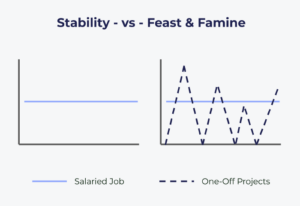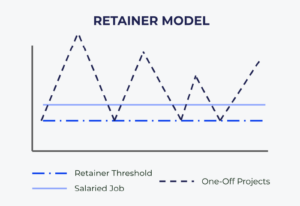Retainer offers are one of the easiest and fastest ways to diversify AND stabilize your income. Retainers stabilize income because it’s a source of steady, monthly revenue. Knowing I had a reliable income made the jump to full-time entrepreneurship possible. And I want to share how you can get that stability too.

What is Retainer Work?
Chances are, your client hired you to solve a problem they couldn’t solve on their own due to time, energy, skill, or knowledge. You’ve provided a solution, and most solutions require maintenance for long-term impact.
A retainer offer is when you work with a client on a recurring basis. They pay a set monthly amount in exchange for your business holding a set number of hours or deliverables.
For example, in my business, retainer clients get a monthly VIP design day or data analysis. I have students who offer social media marketing, copywriting, and branded photoshoots.
With a retainer contract, your client gets consistent access to you and your services in exchange for a reduced rate (typically).
This stability means they can lock in your rates, plan their day-to-day workflows, build strategic plans as the CEO, and improve over time because they have consistent access to YOU.
They don’t have to:
- Re-introduce someone to their business strategy each month.
- Re-explain goals and audience.
- Educate you on their offer.
Which saves them time and money.
Instead, you already know it and can notch in seamlessly. It provides you with predictability with income and workload. It helps you build a referral network of satisfied customers. And as a bonus, you get to refine your communication processes. You get paid a little less, but you KNOW you’ll have that money each month. And as a bonus? You have more time because you’re not having to market as heavily.
Retainer relationships are a win-win.
Stabilize Your Income By Raising The Bottom Line
There are peaks and valleys throughout all facets of entrepreneurship—client flow, cash flow, marketing, things that worked and didn’t. We aim to figure out how to fill in some of those valleys a bit—diversifying your income streams.
Doing this will let you focus on growing rather than constantly building. Providing the stability you need for consistency and creativity. We want to create a Retainer Threshold. Raising your bottom line so that those valleys don’t seem so steep.


Designing an Experience
Choose Your Retainer Model:
A retainer contract is essentially a subscription for a client to access you and your work. There should be a process in place for clients to use the time they’ve reserved with you. There are two basic models:
Hourly Model:
Benefits:
- Paid for the time you spend.
- Conventional and easy to explain.
- Protection from scope creep.
Limitations:
- Close monitoring.
- Incentivizing speed over the outcome.
- ROI is tied to time rather than value.
Deliverables Model:
Benefits:
- Paid for the completion of tasks.
- Processes can be streamlined.
- Clients can be more hands-off.
Limitations:
- *Sometimes* harder to sell vs hourly.
- Difficult to predict time commitment.
| IMPORTANT NOTE – EVERYTHING is hourly when it comes down to it!
You have to set aside time in your schedule or else you’ll feel stressed out. By setting aside the time you’ll need to work with your retainer clients, you’ll be able to maintain a schedule without neglecting your other tasks. You’re both getting stability out of this agreement. Remember, they’re getting consistent access to you and your services in exchange for a reduced rate. |
Build Your Offer:
Consider the questions below. I find it easier to create a retainer offer for a service that already exists and that I know resonates with clients because they’re already buying the service.
Brainstorm Packages:
- What is your primary offer?
- How much time does it take?
- What does it cost?
- How do you provide support?
- How can you continue the experience?
- How could you provide ongoing value?
- How could you support implementation?
- What happens when a client finishes working with you?
- Is there maintenance?
- Do you enjoy doing it?
| IMPORTANT NOTE – Your retainer offer should be a natural continuation of your primary services. |
Services That Make Good Retainer Offers:
- Social media management
- Branded photoshoots
- Pinterest management
- Content strategy
- Digital Marketing
- Website maintenance
- Copywriting/ghostwriting
- Quarterly mini-sessions
- Sales or landing page design
- Launch support
- Lead magnet design
- Systems management
- Trend analysis
- Updating listings
- Research
- Digital ad management
- Pitching for podcasts/interviews
- Sales funnel design and audits
- Bookkeeping and payroll
- Marketing support
- Podcast or video editing
Policies + Access:
Next up, we must figure out who has access, when, and how. This becomes the foundation for a contract, showcasing exactly what is included in your retainer offer.
Who Gets Access?
I recommend starting with giving access to past clients only.
They’ve already been vetted. You know how they work. They know how you work. You’ve got a strong working relationship which will make this an easy sell. They’re in your system. They know your process. They’ve seen your ROI.
Working with past clients allows you to continue your relationship with them, build your referral network, and, most notably to the client… you become an integral part of their strategic planning. They know they get consistent, reliable results, which means they can confidently plan for long-term projects and launches.
Retainer Specific Policies:
You’ve already got your policies around Intellectual Property Rights, copyright, communication, etc. Now you need to create some policies specific to retainer offers. Because this is an ongoing relationship, meaning your client will pay you monthly indefinitely, you need to communicate some rules and boundaries to help nurture a positive working relationship.
Here are some questions to think about:
- Do hours or deliverables rollover?
- How much do you discount?
- How often do you follow up?
- How long is the initial engagement?*
* Initial engagement can also be termed a trial period. I typically do three months where we both commit to working together for three months so that they can truly see the ROI. In the first month or so, it’s hard to pinpoint ROI, and it’s easy for a client to feel that a retainer isn’t worth it. And we don’t want that! An initial engagement or trial period is great for everyone involved.
Retainer Offer Template
Use this template internally or when sharing your new retainer offer with clients. It’s a starting point to help you organize your offer and start having conversations!
Retainer Offer:
I plan to offer retainer services for [cost] on a [timeline] basis. This retainer is [type: deliverables or hourly] and the scope of work includes: [what is included].
[Retainer-specific policies.]
This is only available to current and past clients.
Each [timeline], I will bill the client. [Rollover Policy].
Clients must commit to at least [length of initial engagement].
[Refund policy].
Share Your Offer
Many clients can’t see why a retainer would be valuable. Or they know the value but are worried about adding another task to their list – managing a retainer contract. It’s one of the main reasons I suggest working with only past or current clients – they know you, your value, and that you’re here to help them grow – not steal their money.
It’s our job to show them that we can become an asset to their business when kept on retainer. Showing, not just telling – which is why I want you to map your current process.
Map Your Process
Look over your project workflow; hopefully, you have it mapped out. You can see my workflow here as a starting point if you don’t. When do you send automated emails? How can you create a strong customer experience that builds a relationship and trust? Using a tool like Honeybook, you can look over your workflows and see where you can enhance your current process through automation!
By mapping our process, we can showcase how we manage a retainer contract – alleviating concerns or fears from the client AND ensuring that we always know the next step. So, next up, we wanna share our offer – and sharing is just the beginning of your retainer relationship.
Sharing Your Offer Through Education
Throughout the project, sprinkle in education moments for clients to get a feel for how a retainer relationship could help them grow. This might be referencing other retainer clients, sharing a testimonial, or client win in your weekly “clients only” email.
As you map your process, here are a few places you can educate your client on the value of retainer work:
Before you work with a client:
- What could you share to make a “yes” easier? – we want to be able to capture micro-education opportunities with our new process.
- Share that your service is part of an ongoing ecosystem – it’s not “one and done” – this is critical if we want to ensure clients are prepared for retainer services if we offer them.
Onboarding:
- Where can you share glimpses into your retainer process without inviting?
- Get their mailing address. Send snail mail to stand out. I like to send encouraging notes!
- Uncover their long-term strategy + where they’ve struggled before.
During the initial project:
- Set the stage for trust.
- Provide support within scope.
- Communicate expectations + showcase the process.
- Consistently connect to build trust.
Off boarding. Building the Case + Creating a Roadmap + Invitations:
- Talk about the next steps for success.
- End of Project Strategy Call.
- Create a roadmap as part of “off-boarding.”
- Set an end date.
Remember: You’ve provided a solution, but it likely requires maintenance.
Use the end-of-project strategy call to help them know their next steps and what needs to happen to get the most out of their investment. If this is the first time they’re hearing about maintaining their project, they’ll likely say no. Show them the roadmap you’ve created for them as part of the off-boarding process. Talk them through it like it’s a sales call (because it is!). Explain the value and why this roadmap is so important.
Your roadmap becomes the tasks that need to occur as part of the retainer contract.
In each project stage, you can plant the idea of your client continuing to work with you. You’re essentially beginning the sales sequence again. And you can do this through automation and conversations.
If you’ve delivered your offer as promised and your working relationship went well, we know it tends to be easier to retain a client than to find someone new. The time spent helping them see how your initial project had a strong ROI and that continued work will have an even better ROI. You’ll keep inviting them to continue to work with you.
Show up. Build Trust. Create Relationships.
Throughout the project, listen to your intuition – do you want to keep working with this person? Are they a good fit for a retainer relationship? Is this someone you’d be willing to show up for time and again?
Showing up means showing up where they are too. Think about your real friends. Do you only show up or engage with them when they’re literally at your table? Or do you stay in touch, encourage on social media, send notes, and keep connected? Hopefully, you keep connected.
After all, that’s one of the ways we build relationships. Relationships – in my experience – are built on connection, community, support, and then eventually trust. We want that too. By showing up, we’re setting the stage – which will help us in the project and if we decide to pursue retainers! Like building blocks, we’re building trust one step at a time.
And just like relationships, retainers can help you grow your business. Good luck!
If you want to learn more about designing retainer offers, strong client relationships, and building trust through design, join me {for free!} as we explore human connection and remember that numbers are people too.

